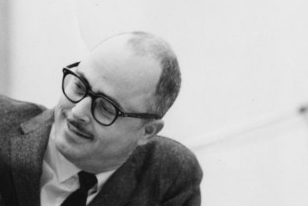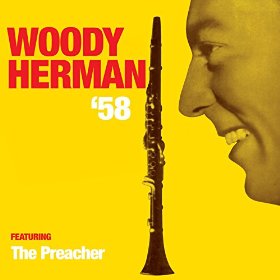Wailin' In The Woodshed – Gene Roland
A very simple and catchy swing song. A three-horn arrangement taken from the original big band chart is available.
- Recording: Woody Herman - Woody Herman '58
- Recorded on: July 2, 1957
- Label: Verve (MGV8255)
- Concert Key: B-flat
- Vocal Range: , to
- Style: Swing (medium)
- Clarinet - Woody Herman
- Tenor Sax - Bob Newman, Jimmy Cook, Jay Migliori
- Bari Sax - Roger Pemberton
- Trumpet - Danny Stiles, Bill Castagnino, Andy Peele, Bill Berry, John Coppola
- Trombone - Willie Dennis, Bill Harris, Bob Lamb
- Piano - John Bunch
- Bass - Jimmy Gannon
- Drums - Don Michaels
0:00
0:00
Buy MP3
Purchase Wailin' In The Woodshed - Gene Roland
Purchasing this song through our affiliate links with certain retailers provides jazzleadsheets.com with additional support to help keep us bringing you the best lead sheets available. Thank you!
Video
- Description
- Historical Notes
- Solos
- Piano Corner
- Bass Corner
- Drum Corner
- Guitar Corner
- Inside & Beyond
- Minus You
A classic swing riff head, based on repeating V of V motion (alternating C7 and F7). The melody has more than a passing resemblance to Duke Ellington and Billy Strayhorn's Satin Doll, but this song is harmonically simpler. Like many big band swing riff heads, it works well in any small group setting.
Note from Don Sickler:
We've been getting more requests for easy sextet arrangements, and after listening to Gene's arrangement for the Herman band, I realized that I was basically hearing three-part voicings. Having had the opportunity to play in one of Gene's bands myself, watching him build the band's book by molding arrangements to the current band's instrumentation, I took a page from his book and adapted Wailin' In The Woodshed for three front-line instruments.
About the arrangement:
The sextet arrangement available here is based on some of the original voicings for the melody in the big band version. Most striking about these voicings is the second measure of the B section (the fourth is the same). Here, the chord is essentially a B♭7 with a ♯9, as played by the rhythm section on the recording. However, the horn voicing contains A♮; the 7th of the chord would be A♭. This results in smooth voice leading, so rather than change the voicing, we decided to give the chord a different name for the head. Since the four-horn voicing in the big band arrangement here is the same as a D minor chord with a major 7th, this chord is written Dm(maj7)/B♭. On the solos it is B♭7(♯9). Also note that the coda, in the original version, comes out of a sort of shout chorus rather than the head. It fits with the head as well, so we chose to include it.
All parts (the lead sheets are the 1st parts) only show the solo chord progression above the melody. The Concert Condensed Score shows the full chord progression for the melody, with a separate solo section, and is recommended for rhythm section players.
Note from Don Sickler:
We've been getting more requests for easy sextet arrangements, and after listening to Gene's arrangement for the Herman band, I realized that I was basically hearing three-part voicings. Having had the opportunity to play in one of Gene's bands myself, watching him build the band's book by molding arrangements to the current band's instrumentation, I took a page from his book and adapted Wailin' In The Woodshed for three front-line instruments.
About the arrangement:
The sextet arrangement available here is based on some of the original voicings for the melody in the big band version. Most striking about these voicings is the second measure of the B section (the fourth is the same). Here, the chord is essentially a B♭7 with a ♯9, as played by the rhythm section on the recording. However, the horn voicing contains A♮; the 7th of the chord would be A♭. This results in smooth voice leading, so rather than change the voicing, we decided to give the chord a different name for the head. Since the four-horn voicing in the big band arrangement here is the same as a D minor chord with a major 7th, this chord is written Dm(maj7)/B♭. On the solos it is B♭7(♯9). Also note that the coda, in the original version, comes out of a sort of shout chorus rather than the head. It fits with the head as well, so we chose to include it.
All parts (the lead sheets are the 1st parts) only show the solo chord progression above the melody. The Concert Condensed Score shows the full chord progression for the melody, with a separate solo section, and is recommended for rhythm section players.
The late 1950s were a time of transition for the Woody Herman band, popularly known as the "Herd." This album features one of several lineups Woody tried between the "Third Herd" of the early to mid '50s and the first "New Thundering Herd" of the '60s. Gene Roland had written for the "Third Herd"; in 1957 compositions and arrangements of his were also recorded by Tito Puente and Paul Quinichette. There are four other different Herman recordings of this piece listed in Lord discography. so it was a popular choice for Woody.
According to Bill Crow, in his book "Jazz Anecdotes," This particular Herd played more weddings and other private events than jazz gigs; trumpeter Bill Berry referred to it as the "Un-Herd".
For another song from this album, check out Stairway To The Blues.
According to Bill Crow, in his book "Jazz Anecdotes," This particular Herd played more weddings and other private events than jazz gigs; trumpeter Bill Berry referred to it as the "Un-Herd".
For another song from this album, check out Stairway To The Blues.
Related Songs
Email Send Wailin' In The Woodshed to a friend
Send this page to a friend via email. Add your name or email in the first field. In the second, add one or more email addresses, separated by a comma.

Gene Roland
September 15, 1921 – August 11, 1982
The only composer with the distinction of working for Stan Kenton for all four decades of Kenton’s band’s existence, Gene Roland was born in Dallas, Texas, and began studying the piano at age eleven. Over the course of his career, he mastered many instruments, from trombone to trumpet to mellophonium to drums, but his real success came through his talent as an arranger and composer. Read more...
There was a problem.
...

